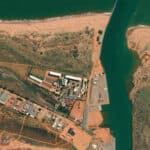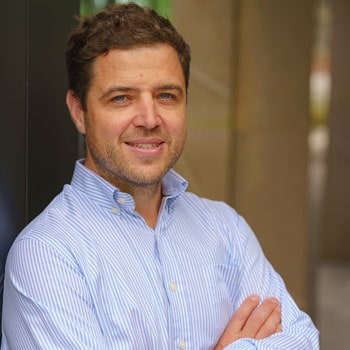In this fascinating chat, Luke shares some of the history of PIANC, along with his own experience with WGA in the maritime industry in Australia and beyond. In the context of real projects, Luke gives us his thoughts on better deploying the right solutions at the right moments. It’s very easy for something to go from being the right answer to the wrong answer, just because of a few subtle details. And he offers a call to arms – take advantage of events provided by PIANC and other industry organizations, where people are brought together, and at least get talking in a room about common issues, and hopefully see eye to eye on more things than they disagree on. Creating the conversations in a realm that isn’t contractual or commercial can only lead to good outcomes.
The Right Solution at the Right Moment

The Right Solution at the Right Moment
Luke Campbell:
- LinkedIn linkedin.com/in/luke-campbell
- WGA profile wga.com.au/our-people/luke-campbell
PIANC Australia and New Zealand pianc.org.au
Concrete Institute of Australia concreteinstitute.com.au
Australian Corrosion Association membership.corrosion.com.au
View the Transcript
BRENDAN: Well, good day, everybody! Thanks for listening in to MARKHAM’s latest podcast segment, our Invisible Strength series.
Today, we are very privileged to have with us Luke Campbell of WGA. Luke is a professional maritime and structural engineer, licensed nationally, and has over 18 years of experience in designing complex coastal and maritime projects for government and commercial industries. Luke is chair of the board for PIANC, Australia and New Zealand. PIANC was established in 1885 as the World Association for Waterborne Transport Infrastructure. Indeed, it was at the recent PIANC event in Melbourne that we crossed paths. I see we’ve got the abstracts through today, which is interesting, and we’ll certainly be digging into that in some more detail.
So welcome aboard, Luke! Good to have you with us and thank you very much for your time.
LUKE: Thank you, Brendan.
BRENDAN: Did you want to perhaps touch a little bit on the work you’re doing with PIANC, as a bit of an introduction, particularly in the space of new infrastructure?
LUKE: Yes, PIANC is a fantastic organization. I’ve been tangled up with PIANC in some capacity for our best part of 15 years, most recently on the board of PIANC here in Australia and New Zealand, and now the chair. PIANC historically was set up, actually, as part of the formation of the Suez Canal. They tried to gather the best and brightest people from all around the world. In a way, that wasn’t really done at the time. But just trying to say, well, what is the state-of-the-art engineering knowledge in the world to facilitate such a project? It was such a successful endeavour that they all agreed that it was something that should be continued, so it’s been going ever since. It was initially just like a congress conference-style thing. But now it’s a very organized body, operating largely out of Brussels, but with national sections around the world.
The Australia and New Zealand chapter punches well above its weight, in all sorts of things. Actually, it’s one of the most active chapters in the world, and we’ve got people working on all sorts of interesting things. But primarily, PIANC is known for its technical documents called Working Group Papers that can be thought of as mini-standards. They differ from standards and codes that we often use, in that they’re generally more readable, a lot more conversational, less technical. Probably the assumed technical knowledge behind them is easier, and they read more like a book. So they’re certainly sought after in terms of when people are chasing answers to tricky problems, wherever they might be. They cover things around durability and port operations, and certainly overlap with plenty of things that feature in Australian standards and the like.
BRENDAN: Yes, that’s very interesting. I’m particularly interested in the history of it. To be honest, until we had been to a couple of the seminars, I hadn’t known too much about the organization at all. So it’s good to get that. What sort of projects do you get involved in, in Australia and New Zealand? It’s particularly the new side of the infrastructure, or is it remediation work as well?
LUKE: Well, it’s all sorts. It’s really answering the call of what the port industry needs. It does stray into environmental and coastal engineering issues as well. So it’s not just relating to port structures or port infrastructure, it’s the whole suite. There’s a real focus on working with nature. That is, trying to find mutually beneficial outcomes where you can achieve good environmental outcomes, and good operational and functional outcomes, particularly relevant when it comes to things like dredging projects and beneficial reuse of sediments. Yes, it’s a broad church.
The working groups committees are formed by industry, they’re full of both design engineers and consultants. There’s a lot of contractor input, there’s supplier input, and I think that’s really what sets it apart. It’s what leads to these pragmatic outcomes, where you get these useful documents that are hopefully only 100 or 200 pages, not a thousand! and where you can actually go in and the layperson can actually find some good and useful advice, not just to actually get bogged down in formulas and coefficients and empirically derived outcomes.
BRENDAN: Yes, that’s fair enough. It’s a little bit, I suppose, deviating. We were going to talk about the choices in design factors. “Horses for courses”, I think, we’re basically calling this one. But before we sort of get into that, do you get involved in bringing people together, working as a sort of a hub between contractors and people that are managing the assets and so forth?
LUKE: Yes, look, I mean, I’m talking wearing my PIANC hat in the first instance, but I’ll drag my other day job into play here. Mostly, I’m a design engineer and consultant for WGA, working on infrastructure projects, mostly ports and marine type stuff, is certainly my favourite. So that’s a daily occurrence. The thing that makes me so passionate about PIANC is, is you really get to take that experience and try and translate it into something that is accessible to suppliers, contractors, clients, end users alike, trying to bring those learning experiences together.
So if we come back onto the topic that you and I’ve been discussing over the last couple of weeks, it’s just trying to find better ways to deploy the right solutions in the right moments. I think that as an industry, we probably all deserve a pretty poor mark for how good a job we do about not confusing end users and people who get to actually make decisions and say yay or nay onto whatever proposed solution might be put forward, by perhaps yourself as a supplier or ourselves as a designer, or whatever it might be that a contractor is proposing, with a view to ease of installation or whatever it might be.
As an industry, I think we’re generally quite terrible at it; we confuse people really quickly and easily. Most people are correct in what they’re saying, and it’s definitely not that there’s any sense of malice involved. But it’s just, I think we forget how overwhelming this can be for people who are trying to take these really quite complex durability challenges, corrosion environments, and then the technologies that are deployed in the solutions. It gets very technical very quickly. I’ll happily say that even as someone running a team of 100 odd engineers – who are pretty clever people, and fairly well-versed in this stuff – it’s difficult to actually get people up to a working level where they can cover the bandwidth with appropriate detail. It’s a really challenging thing.
So if we’re trying to ask some asset owner who’s got 25 other extremely important things that they also have to cover; if we’re trying to expect them to get to that same level and be able to have a meaningful conversation and be able to sort the wheat from the chaff, then we’re setting ourselves up to fail as an industry. That’d be how I’d sort of launch ourselves into this subject.
BRENDAN: Yes, that’s fair enough. I guess one of the questions would be, how did we get to this point? There’s a bit of a history on the way things used to be run by perhaps a single entity or an overarching entity more, and now we have a good deal more players on the field. Is that a fair way to look at it?
LUKE: I think it’s that, but it’s a combination of many things, I’d say. I mean, certainly, there’s a general de-skilling. There’s less generalists out there. There’s a lot more people who focus on what they need to do, and they rely on either buying in help, or getting contractors to fill the gap, or certainly relying on the technical expertise sitting with suppliers to give them good answers.
I guess the question becomes, what do they do – if they’ve got two people that they should supposedly trust because they know more about it than they do: What if they’re telling them different things? What do they do if they’re telling them things, where it’s hard to tell how they can both be right? Now, in my experience, most often, both people are right. The reason why it’s confusing and why it sounds like they’re saying something contradictory is because, well, they’re talking about slightly different things. They’re talking about something and they’re using general descriptions of how things generally perform; and trying to right-size them for a situation where they might not be fully informed just yet. So it’s very easy for something to go from being the right answer to the wrong answer, just because of a few subtle details.
If we take something like a concrete repair, or a concrete durability issue, is it best to solve it with a mix design or not? Is it best to solve it from day one, or not; wait 10 years before you do something and intervene? The complex array of variables here, including the design life, the certainty of what the future use might be, whether there’s good quality control, because you’ve got very good ready-mix suppliers around, or whether you’re very remote and you might be either using pretty crude facilities or having to batch your own stuff. So the number of variables very quickly outweigh those that can be easily factored into a nice table, where someone gets to run their finger down a list of potential solutions and pick a winner.
So again, I think the challenge and the thing that we need to get better at – again, there’s some great organizations, like the Concrete Institute and PIANC and certainly plenty of others. The Corrosion Association is very good. Those are fantastic groups, where they do try and bring certainly suppliers and contractors and technologists and scientists and engineers and designers, and hopefully asset owners. They try and bring all of these people together, and at least get them talking in a room about common issues, and hopefully seeing eye to eye on more things than they disagree on. I think just creating the conversations in a realm that isn’t contractual or commercial can only lead to good outcomes.
BRENDAN: it’s remarkable you say that actually, because in one of our early [podcast] episodes we had a waterproofing consultant in the construction industry, and pretty much said exactly the same thing, that we need to get people together early in the development stage of a project as a way of avoiding major issues down the track. Is that something you would want to convey to contractors, perhaps, like ourselves? You mentioned the concrete industry, that’s the direction we’ve come from of course.
LUKE: I think so. I think we have to be far more willing to… Look, we all work in competitive industries, where, I mean, hopefully you don’t have to pooh-pooh the opposition, but you hopefully have to at least try and demonstrate that you’re a better value for money proposition to try and win work. We’re all tasked with that challenge, to try and have successful businesses. So that can’t be avoided. But I think we have to be really quite willing to accommodate the alternatives.
Now, there’s trivial examples I think you might use, such as, say, concrete admixtures. You’d look at some of the fantastic things that crystal growth technologies can do in terms of waterproofing, or general durability for various concrete structures. But then there’s things they don’t do very well, or they can’t do; things like dealing with live cracks, or dynamic cracks, or thermal effects. They’re not the right solution there. Now if someone’s marketing their product and haven’t been able to give enough description or understand the project that that could be in play, what can you expect them to do other than market their product to that solution? They may be wrong for reasons that aren’t their own.
So look, I think just going with an open mind. I think we all gain respect in industry when we actually suggest that there might be an alternative that’s better than what we’re proposing at the time, and maybe in this instance, they should be going down that path and not our own. You’d like to think that there’s always a chance for that sort of humility and just general good advice to come into play. I think the thing that we all need to make sure is that we take our sales hats off, and make sure that we let the technical specialists advance their cause. They exist within every business, and equally, you can’t have any business without people with more of a sales marketing focus as well. So I guess I’m just talking about the Goldilocks scenario, finding the right balance, where the blend looks good, and you get the right mix of marketing guff with technical support and backup.
BRENDAN: Yes, that’s good. So would you say the need for the representative at the coalface to understand the need? A two-way street, would that be a fair way to put it?
LUKE: Look, it is; and I think the call to arms I would put here is that, if you look at conferences and professional organizations—PIANC, ACA, Corrosion Institute, or otherwise—they’re generally quite well supported by designers and consultants who, I guess they are hungry for the knowledge and probably hungry for the networking as well. Suppliers are pretty good. You do get a pretty good contingent of people who support these conference series with their booths and their space sections and the like, and they’re pretty good at sort of mingling. I’m often surprised about how few contractors we see. I’m guessing, often the work demands for their people are such that someone is really untouchable for a few months, because they’ve got this thing that all revolves around them on some site or something like that. But I do think there’s a huge benefit to getting contractors in the mix. And they do support it; I’d just like to see more.
But I think in particular, getting more of the sort of asset owners, asset managers, the end users, the people that actually ultimately perhaps make some decisions about whether they choose Option A or Option B—or they have to try and sort out whether it’s worth spending more money to get this outcome and whether that is going to pay a dividend over the whole of life—they’re the ones who I’d like to encourage to get more involved in some of these forums, because that rounds things off nicer.
BRENDAN: Yes, that’s a good point. I can understand, particularly, I suppose, given the size of or depending on the size of the contractor, whether they can dedicate people to go along. But the long-term benefit of understanding the needs of what they’re dealing with would be a major factor, wouldn’t it?
LUKE: Oh look, it is. I think on that note, all of these groups that I’m giving examples of have got local state-based representations. They’re not just national things, where we have to get on an airplane and fly to something. They’re very accessible. It’s just of vital importance that you get a nice cross-section in size and scale, so that people representing businesses who have got 3 or 5 or 10 people, are just as important as those representing hundreds or thousands. Because if you look at the suite of projects that we’re all answering to and we’re all trying to satisfy, it’s absolutely no use to anyone if we’re only pushing things that are warranted, when you’ve got the real big end of town with access to whatever plant and equipment is required and budgets to suit. We have to make sure that we can right-size all these solutions to suit whatever application it might be.
BRENDAN: Yes, that’s a very good point. It’s a matter of having a broad outlook. I think you might have used the expression when I was talking to you before, the chat about blinkered. Was that something you’d like to talk about, as far as working with others?
LUKE: Look, I think so. I think, particularly anything that starts with engineers and scientists and those associate technical fields; everyone becomes a boffin of, to some extent, passionate about the thing they’re in. They probably can’t understand why people avoid them at dinner parties or barbecues when they start going on about the thing they think is of great interest! We’re all guilty of it to a certain extent, where we think how can anyone think this is anything but fascinating? The reality is, for a lot of people, it’s not.
So yes, I think you can get blinkered in your approach and think that the only thing that matters is what you’re talking about. Whereas, having these broader conversations by these technical platforms and technical working groups, things that exist in various forms, that just leads to better outcomes. It might lead to nothing other than you picking up the phone and calling that person that you met who’s got that very different background and say: Hey, I’m thinking about doing either this or this, what do you think? In my experience, that phone conversation costs you nothing, and what it probably does cost you is someone doing the exact same to you in a few months and reciprocating. They’re pretty sure they know what they want to do, but they’re just not quite certain about something they think you might know more about than them. So those things are gold; they allow you to advance at a moment where you otherwise might get bogged, or you might proceed without the level of certainty needed. I mean, you can build those relationships by projects as well. But you can certainly expand that network much faster by these professional organizations.
BRENDAN: That’s excellent, excellent advice. I love the suggestion about reciprocating, I’d like to see more of it, perhaps sometimes for us as contractors to pocket our pride and ask for help, or ask for what we’re missing perhaps in the picture.
LUKE: Yes, and maybe you’re missing nothing. I mean, the worst thing that can happen is you spend a few times where someone agrees with you. That’s the bad version of that conversation.
BRENDAN: Yes, fair enough. That’s fair enough. Well, I didn’t want to digress too much on here. But I did notice you’ve had been involved in a remote project a bit earlier in your career, and I wondered if you were able to talk about that. I like the elements of the challenges on the site, and bringing things together.
LUKE: I’m not sure which project you’re referring to, that’s probably most of my projects I was involved with. I’ve generally been out in the boondocks doing something!
BRENDAN: I think it was on the WGA site. But if you’ve got a more recent example where you can talk about practical elements, we would love to hear about it.
LUKE: I mean, they’re all the projects that I’ve enjoyed the most. I mean, it might be the Wyndham Jetty, where we were doing something up without really no access to ready-mix concrete or anything. Yes, you get pretty inventive trying to find a way forward in those instances. We’ve done things in all sorts of remote parts of Australia and nearby.
I think that’s what excites me about our industry, full stop, in the ports and rain maritime world; is that when you’re doing something within a CBD area or greater metro Perth, wherever it might be, you’ve got lots of things available to you. You can sort of really have any concrete mixture you like, or expect to have access to any crane you want, or whatever it might be. But in some of these other areas, the costs of mobilizing that crane might be couple of million dollars by the time you’re done with it, or the challenge of getting that concrete mix might be setting up a batch plant at the cost of many hundreds of thousands, and the project can’t support it.
So that’s where we’re working closely with contractors and understanding what local markets can achieve, versus what you might bring in on a truck. Those things become far more important as things that govern your criteria on your project than what your codes and standards spit out from analysis. You’ve really got to do that, that’s second after you’ve made some far more important decisions about how you might tackle the real problems.
BRENDAN: Yes, that’s fair enough. I’ve seen one or two cases like that. But normally speaking, we’re in the zone of being fairly convenient. But I do like the thought of bringing things together almost from scratch as it were.
LUKE: Well, what I was just doing just before I walked in here, I was doing some concept design for a project, which is not super remote. It’s got access to certainly batch plants where they build plenty of house footings and low-grade to the commercial and industrial slabs and things like that. But we might be at most able to get like an N32 concrete. So someone made a decision fairly early on that, therefore, for the marine project we’re looking at, we probably have to make sure we don’t use any local concrete. I said, Well, no, that’s really not true at all.
I mean, if we can get an N32, and we can add a few bells and whistles to that and take that to at least something that is getting pretty close to something we could live with. Once you start, when you’re done with admixtures and different types of reinforcement and building in provision for future cathodic protection and other things; I said, There’s really nothing stopping us from getting a good outcome here. We don’t need to enforce some fancy S50 mix to be able to deploy in-situ concrete. We can absolutely pull enough levers to get over the line.
I mean, the person who made the decision that it wasn’t appropriate, they’ve got a reason. They’ve made that decision based on their prior experience where they’ve been trying to get good concrete. But it’s a simple matter of have we asked all the right questions to see if we can really get that done or not? In this instance, I think that’s something that we can get there.
BRENDAN: That’s brilliant, I love it.
Well that’s good, Luke. I don’t want to keep you unduly. Did you have any other closing thoughts on the topic? Then we’ll wrap it up.
LUKE: No, just, case in point, this conversation stemmed from us having a chinwag at a conference between think sessions or over a lunch break, whatever it might have been. Extrapolate that, times 20 or 100, would reflect the other conversations that were generated just for myself alone at that one conference. Conferences are one thing. But here in Perth, with our PIANC local chapter, we probably catch up five or six times and get 50 or 60 people along. The Corrosion Association and the Concrete Institute would be similar frequency. So there is no shortage of opportunities to get in there and get amongst it. I’d almost ignore what the topics are that are being discussed, because that’s really only a part of the story. The other part of it is just the conversations that are generated afterwards and the continual building of networks.
So for those who aren’t actively involved in those sorts of things, I’d just encourage them to get out. Even if it’s just a few times a year, try and get amongst it. Because not only will you get something from it, I’m sure you will add to the broader tapestry of conversations that are otherwise going to happen there.
BRENDAN: That’s pretty good. Thank you very much.
LUKE: Thank you, Brendan.
BRENDAN: Anybody wants to get in touch with you, just via LinkedIn or what’s your best avenue?
LUKE: Yes, I’m easily found on LinkedIn, or you’ll find things about the WGA website.
BRENDAN: Fair enough. Well, thank you heaps for that. Really appreciate it, and appreciate your time.
LUKE: No worries, Brendan.
Want to Contribute?
Feedback on our podcasts? Suggestions for future topics? Looking for more information on topics we’ve discussed? Send us a message – we’ll be in touch within a day or two.
More about MARKHAM
MARKHAM are dedicated to providing innovations for concrete and construction. Focusing on concrete waterproofing solutions, penetrating concrete sealers and durability treatments for concrete.
Podcast Categories
Latest Episodes

The Electric Vehicle of Cement Making
We’ve talked about this in other places, but cement manufacturing is a real problem child

Eco Choice – People and Planet Focus
Environmental Choice New Zealand has had a makeover – now it’s called Eco Choice Aotearoa.

Starting Good Conversations
Have you seen those colourful Trademutt shirts on site? They’re a conversation starter! This is
invisible strength podcast
The whole MARKHAM team is pleased to present you with our podcast series, INVISIBLE STRENGTH. In this series of interviews, we’ll walk through the science and challenges of concrete durability, what goes wrong in the field – and the advanced methods available to restore and enhance service life to concrete construction.
INVISIBLE STRENGTH reflects a number of factors in concrete construction and durability. When things go wrong, the evidence can become very visible indeed. However, when all is going well, there’s nothing particular to be seen!
MARKHAM’s concrete treatments, too, are invisible once completed – and the result is the long internal, invisible durability of the concrete.
So join us as we explore the unseen world inside concrete – why it matters, and how it can be protected!
Stay Connected
Listen and subscribe to us on your favourite podcast platform, we're always adding new episodes!
Newsletter
Sign up for email updates on the latest collections, campaigns and videos.
